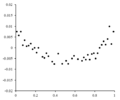Least squares facts for kids
Least squares is a cool math trick used to find the best fit for data. Imagine you have a bunch of dots on a graph. Least squares helps you draw a line or a curve that gets as close as possible to all those dots. It's like finding the "average" path through your data.
Contents
What is Least Squares?
When you have a set of numbers or measurements, you often want to see a pattern. Least squares helps you find a mathematical rule, like a line or a curve, that best describes these numbers. It does this by making the total "error" as small as possible.
How Does it Work?
For each data point, we measure the distance from that point to our chosen line or curve. This distance is called a "residual." Some residuals might be positive, and some might be negative, depending on whether the point is above or below the line.
To make sure positive and negative distances don't cancel each other out, we square each residual. Then, we add up all these squared distances. The goal of least squares is to find the line or curve that makes this total sum of squared residuals as small as it can be. This gives us the "best fit" line or curve for our data.
Who Invented Least Squares?
The idea of least squares was developed by two brilliant mathematicians around the same time.
Carl Friedrich Gauss (a German mathematician) said he came up with the method in 1795. He famously used it to find the lost asteroid 1 Ceres. Ceres was first seen in 1801 but then disappeared behind the Sun. Gauss used his new method to predict where it would reappear, and he was right! He published his work on least squares in 1807.
Adrien-Marie Legendre (a French mathematician) also developed the same method independently. He published his work in 1805, which was a bit before Gauss published his. Because of this, both mathematicians are often credited with inventing least squares.
Related pages
Images for kids
See also
 In Spanish: Mínimos cuadrados para niños
In Spanish: Mínimos cuadrados para niños




